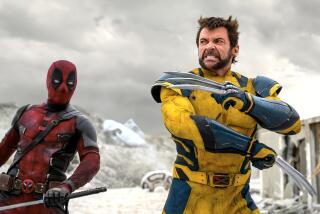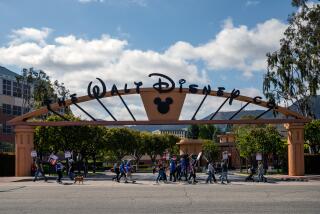COMPANY TOWN : Disney reshuffles at top, posts profit gain
- Share via
A high-level executive reshuffling at the Walt Disney Co. on Thursday will give Chief Executive Robert A. Iger a deeper bench from which to choose a No. 2.
The restructuring came in advance of the company’s fourth-quarter earnings announcement. Disney reported an 18% bump in income, fueled by gains in the television group that helped offset a loss at the film studio and softness in the theme park business.
As part of the management changes, Chief Financial Officer Tom Staggs will trade jobs at the end of the year with Parks and Resorts Chairman Jay Rasulo. Iger said the cross-training initiative is intended to give the two longtime executives broader experience.
Staggs, who has been Disney’s CFO for 11 years, is well-regarded on Wall Street but lacked the operating experience that would position him for the No. 2 post. Rasulo, who has run the parks since 2000, will get a more visible role as the company’s principal contact with the investor community.
“It’s something that was my idea, something I broached with them a number of months ago, but waited to implement until things stabilized,” Iger said in an interview.
On the company’s conference call, Iger credited Staggs, 49, with playing a key role in the acquisition of Pixar Animation Studios and the pending deal with Marvel Entertainment Inc. He acknowledged Rasulo, 53, for overseeing major expansions of Disney’s California Adventure in Anaheim and Hong Kong Disneyland, and in shepherding the long-anticipated theme park in Shanghai, which last week gained approval from the Chinese government.
This is the second major executive shake-up at Disney in recent months. Walt Disney Studios Chairman Dick Cook was ousted in September, after a series of costly misfires including “G-Force,” “Bedtime Stories” and “Surrogates.” He was succeeded by former Disney Channels Worldwide President Rich Ross, who has wasted little time in reorganizing the studio, ousting top marketing executives associated with lavish, if lackluster, promotional campaigns, and elevating other executives with experience in digital distribution platforms.
The studio remains a drag on the company’s balance sheet.
Disney reported net income of $895 million, or 47 cents a share, a gain of 18% compared with $760 million, or 40 cents a share, a year earlier. Revenue rose to nearly $9.9 billion, up 4% from $9.4 billion a year earlier.
The film group reported a $13-million loss for the fourth quarter, compared with operating income of $98 million a year earlier.
This represents the second consecutive loss for the studio, reflecting higher write-downs on newly released films and a drop in music sales.
“As our numbers indicate, our studio had an extremely disappointing year in 2009,” Iger said, blaming the studio’s live-action movies and broad changes in the industry. “Our choice of Rich Ross as head of the studio is designed to redirect and improve creative endeavors as well as to immediately and properly address the secular changes we’re seeing.”
Iger told Wall Street he was less than “elated” with the $31-million opening weekend domestic box office for the studio’s latest release, “A Christmas Carol,” a 3-D retelling of the Charles Dickens classic. However, he said he is encouraged by the Veterans Day ticket sales and remains hopeful that it will follow the trend of other holiday-themed films released in early November, which tend to remain in theaters longer and gather momentum over time. He said he is also enthusiastic about upcoming releases, including the new Disney animated film “The Princess and the Frog,” Tim Burton’s “Alice in Wonderland,” Pixar’s long-anticipated “Toy Story 3” and Jerry Bruckheimer’s “Prince of Persia: The Sands of Time.”
The Media Networks Group, which includes Disney’s broadcast and cable television channels, appears to be shaking off the chill of the recession. The television group’s operating income for the quarter rose 26% to nearly $1.5 billion, up from $1.2 billion a year earlier, thanks mostly to ESPN, which attracted its largest audience numbers and increased subscriber fees. The cable sports network’s higher revenue was partially offset by the costs associated with new deals with the U.S. Tennis Open and the English Premier League football.
The broadcasting group reported operating income of $2 million in the quarter, compared with a loss of $71 million a year earlier, fueled by syndication sales of ABC Studios shows, led by “Grey’s Anatomy” and “According to Jim.”
At the theme parks, operating income for the quarter fell to $344 million, down 17% from $412 million a year earlier. Attendance rose 10% at Disney’s domestic parks, partly because an extra week was included in this year’s fourth-quarter results.
Excluding that extra week, attendance was up 3% overall, with a 15% surge in attendance at Disneyland in Anaheim offsetting a 3% drop at Walt Disney World in Orlando, Fla.
Discounts on tickets, hotel rooms and food cut into the amount of money visitors spent in the parks, and revenue fell 4% to $2.8 billion from nearly $3 billion a year earlier. Disney expects to continue the promotions through the spring.
The anemic retail climate affected Disney’s consumer products group, which reported a 28% drop in operating income to $151 million, from $211 million a year earlier. Revenue was off 12% to $646 million, from $735 million a year earlier.
The Interactive Media group reported a loss of $114 million for the quarter, an improvement on a loss of $120 million a year earlier. Increased subscriptions to the Club Penguin online community helped fuel an 8% increase in revenue for the quarter to $157 million, from $145 million a year earlier.
--
More to Read
The biggest entertainment stories
Get our big stories about Hollywood, film, television, music, arts, culture and more right in your inbox as soon as they publish.
You may occasionally receive promotional content from the Los Angeles Times.










